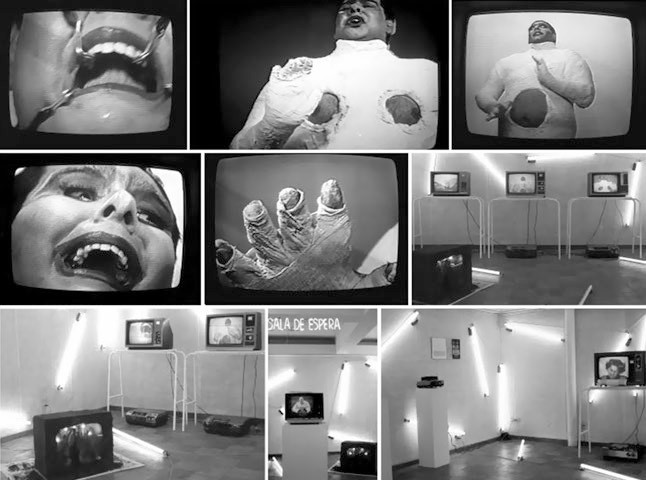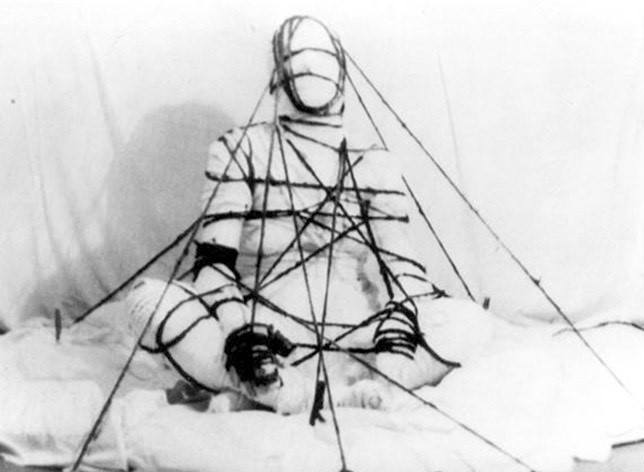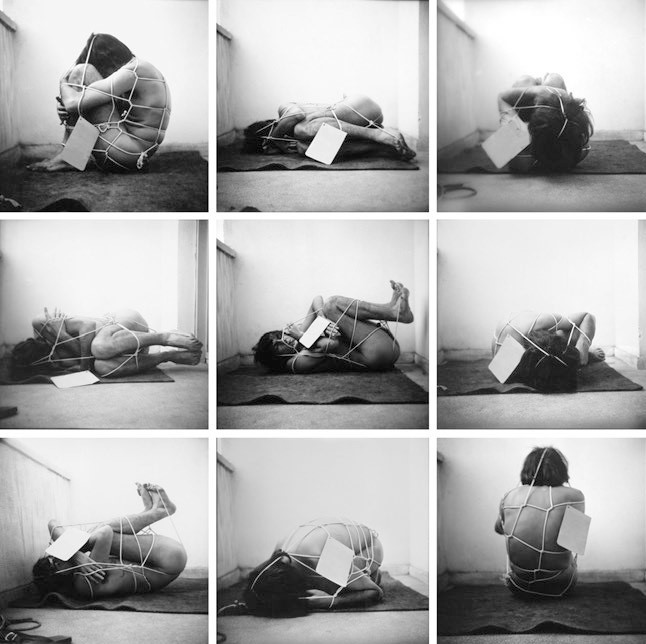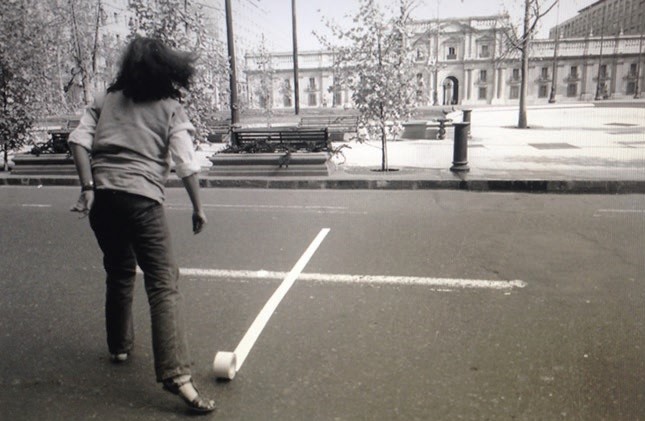Book review: Caterina Preda “Art and Politics under Modern Dictatorships: A Comparison of Chile and Romania” (2017)
An oral book review was presented during the seminar held online on November 22, 2021. The following text is an edited transcript.

[Carlos Leppe, Sala de espera / Waiting room (1980). Source: Preda, p. 226]
Petra Šarin:
Regarding its methodology, Caterina Preda’s book “Art and Politics Under Modern Dictatorships: A Comparison of Chile and Romania” (2017) is a qualitative study in political science with a focus on the art and politics of two opposing dictatorships: the regime of Augusto Pinochet in Chile (1973-1989) and the regime of Nicolae Ceaușescu in Romania (1965-1989). Preda first analyses how regimes imagine the arts and how they use them, and afterwards discusses the ways in which art remains autonomous and can criticize or offer a more truthful version of reality. Preda also says (and the readers must bear in mind that book was published in 2017) that the comparative cultural policies of dictatorships and the artworks themselves are still an understudied field, which is also interesting and relevant for our research seminar and the comparative studies we attempt to do. Some of the central research questions are also relevant for us, such as:
- “How is art imagined and affected by modern dictatorship?
- What are the strategies imagined by the regimes and how are they built?
- How does the artistic space react, and how does it affect the political regime?
- What are the most important artistic manifestations in relation to the political?
- What kind of art do [artists] create?” (Preda 2017, 3)
This book shows that dictatorships resort to common strategies. By choosing extreme examples, Preda developed a framework for analysis of dictatorships’ approach of the arts. Chile is an example of a military regime with a strong repressive character and no interest in the arts. Therefore, it did not see a form of official art develop. Romania is an example of a totalitarian, or even despotic regime, where all artistic expression had to follow the official line, and which demanded that art is politicized.
In this book, the author deconstructs these two considerations by arguing that Ceaușescu regime saw alternatives to the official art and that Pinochet’s regime also created official art and institutionally altered the artistic panorama through the projects it put forward. Preda argues that every modern dictatorship creates its own form of official art, or an official stance on art, but at the same time the artistic expression has the power to criticize, and thus, artists are able to keep a certain degree of autonomy, which allows them to critically examine their environment.
Natalya and Carolina will continue by presenting some further examples.

[Amalia Perjovschi, Annulment (1989). Source: Preda, p. 267.]
Natalya Antonova:
Thank you very much, Petra. Perhaps, it is also worth mentioning the method that the book strives to pursue: the modern dictatorships approach. The book claims that instead of relying on the dichotomy created by earlier research – the dichotomy between authoritarian and totalitarian regimes – the approach of modern dictatorships must be construed, for there is a potential for the new approach to theorise “nondemocratic” regimes of power, to shed light on meanings and effects of ideological control on the field of artistic production (Preda 2017, 8–9). Preda argues (Ibid., 8, 307) that the modern dictatorships approach complicates the notion of centralised and homogenous power: an example is the Pinochet regime, which – according to the author – had a full-fledged programme for controlling the artistic production and, at the same time, adopted free-market policies in regulating the production and distribution of cultural goods.
I think it is extremely important to highlight that in Preda’s argument, the distinction between the Left and the Right politics – and not least crucially, the distinction between Communism and nazism/fascism respectively – ceases to be meaningful (Preda 2017, 6, 33). Controversially, Preda (Ibid., 10) confronts the reader with claims of commonality between Communist and nazi systems of power; the author puts on the same level of comparison the ideological organisation of artistic production in nazi Germany and the USSR:
As in the Soviet Union, for the National Socialist government ”the role of the artist was essential: he served through his work the national community. Art became then a propaganda tool that fell under the arbitrary control of political power” (Richard 1998, 71). If in the USSR writers were “engineers of the soul,” in Nazi Germany they were meant to be “cultural soldiers of Adolf Hitler.” Again, as in the Soviet Union and following the ideas put forward by the vanguard [of the movement], “German society was meant to become, in the eyes of the Nazi officials, a work of art: art was not supposed to represent life, but life had to become a work of art,” with Hitler as its architect (Ibid., 77). (Preda 2017, 24)
In my view, Preda’s characterisation of Pinochetism and Ceaușescuism falls prey to what the author herself envisioned to challenge: the notion of the centralised and homogenous power. As far as ideology of art praxis is concerned, Preda describes (2017, 310–16) Pinochetism and Ceaușescuism as projects of massive surveillance turning the production and distribution of cultural goods from above into a mere instrument of repression and censorship of atomised individuals. Vis-à-vis the notion of the homogenous power, the figure of the artist has a purely contemplative character: Preda’s artist is, as it were, a “privileged witness” (2017, 28) who is “the first to react” and give an aesthetic form to the perceived totality (Ibid., 18), and thereby elevate themselves beyond it:
Artists help to draw possibilities of escape or refuge in the face of overwhelming existences marked by violence and repression. Art creates new worlds, and thus shows how the end of domination is foreseeable. (Preda 2017, 303)
With this, I turn the floor over to Carolina.

[Iulian Mereuță, Captured / Transportable body (1970). Source: Preda, p. 271.]
Carolina Salvi:
To begin with, it is interesting that the author’s purpose is to show some similarities and differences, instead of comparing them as equals or opposites. For this reason, in some parts, she shows that however different official art and its objectives were in each country, some strategies and responses were quite similar. For example, she mentions that in Chile art was supposed to be apolitical, art for art’s sake, and in Romania it was supposed to be political, as a political tool to spread the ideas of the regime. Thus, what Preda portrays is that in both countries art ended up being the opposite of what was proposed, and that art found a way to escape the official regime’s intentions and demands. In Chile, art played out as being extremely political and overtly oppositional to the regime of Pinochet, and in Romania, art for art’s sake was one of the ways artists found to escape the official government agenda. Therefore, there was, for example, the work of Horia Bernea, where he painted churches, as apolitical landscapes, in a period when the Romanian government was destroying churches, as a political response. In Chile, there was the work of Lotty Rosenfeld with the drawing of crosses on the streets, interfering with urban scenarios and transforming symbols of the government, in a moment when art was regarded as a purely aesthetic exercise.
In this sense, Preda undertakes making these connections between both regimes and, eventually, analyzing the points where they connect somehow. She says:
We have analyzed the two official policies concerning artistic expressions separately because they both display the same willingness to completely alter the way in which artists relate to the political, yet the means chosen are opposed. In my analysis, apolitical art in Chile was compared with politicized art in Romania. (Preda 2017, 305)
The author finds, thus, traces that connect both countries, and manners in which art always found a way of being autonomous enough to escape the regimes. To exemplify, there is another link: in Romania, artists were hired and regulated by the State, as some sort of public workers/civil servants and regulated by the State, whereas in Chile, they were funded and regulated by the market, since art was supposedly created for profit.
Preda traces yet another link between both regimes, while also presenting where their particularities differ: she notices the encouragement of nationalism through art and cultural media in both countries, to highlight the importance of art and artists in the dictatorial scenario, but at the same time highlighting dissonance: in Chile, there was the controversial situation of the relationship between art and market, for it was quite difficult for art to be extremely nationalist when the neoliberal market was internationalist.
In addition, it is shown that Chile and Romania used culture to spread the government’s ideals. In Chile, it was mostly through television, and in Romania, it was mostly through cinema. For that reason, in both countries, visual arts and literature were the forms of art that were able to escape the official guidelines. Moreover, it is also interesting that in Romania, in literature, it was very common for authors to use double-meanings, as a way of escaping censorship, and this is a fascinating resource that artists have found. Just to make a parallel, this also happened in Brazil during the dictatorship, and artists in several areas (music, painting, literature, cinema) resorted to double-meaning and metaphors also to escape censorship.
Finally, both of the aforementioned cases show the potential of art to provide escape from the regime, even though they differ in degrees of autonomy and specific strategies in their contesting of hegemony. I believe that those are the main ideas of her analyses of art’s response to the different dictatorships.

[Lotty Rosenfeld, Acción de arte Palacio Presidencial La Moneda (Santiago de Chile, 1985). Source: Preda, p. 223]
By: Petra Šarin, Natalya Antonova and Carolina Salvi.




